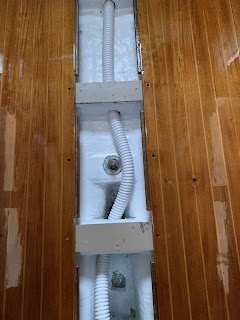Windstar will be reconfigured with 175w rated solar generation and a lithium or AGM house bank with 150ah or greater usable capacity. This requires a relatively compact, low power charging setup that can manage 3 charging sources, and can charge both lithium and lead-acid batteries. An inverter is not required. This works for how Windstar will be used for the foreseeable future.
Before going further it is worth mentioning that 200w solar/200ah would provide independence of any additional charge source. This is tempting for obvious reasons, but would also permit separate and therefore simplified house and starting systems.
AC charging systems that (today) claim lithium compatibility seem to be designed for larger applications. Typically for powerboats, these setups include high output alternators, significant 120v loads, powerful inverters, automatic transfer switching to a generator, etc.... I need none of this stuff.
Is a lithium-ready AC charger actually required? I've been told it is not, provided the lithium battery has on board BMS. This battery Management intelligence manages much of the charging logic, essentially the smarts of a smart charger. Lithium cells themselves are also available, without the BMS. This would explain why chargers cannot make the broad claim of supporting Lithium batteries.
To recap - The system requires:
- Shore power charging - (I have the xantrex Trucharge 20+ unit now. It supports lead acid charging only)
- use of the alternator
- An MPPT solar controller.
- Ideally - each of those systems maintains a charge on both the house bank and the start battery, and can do so without each manually selected. (At the dock the engine could be idling, while the shore power is connected, while the solar is generating).
As I researched, I learned that in the RV world, alternator-powered charging of the house bank (often meaning mixed battery types, sometimes including lithium) is typically accommodated through a DC:DC charger. This device permits the use of mixed battery types by managing a selectable charge profile on its secondary (house bank) side, irrespective of what exists on the primary (starting battery/alternator) side. This is required as the alternator voltage can exceed that which is acceptable to the lithium battery's BMS, triggering its protective circuitry. The DC:DC charger does not replace the AC:DC charger. It is required to manage the alternator's output only, provided the lithium bank's BMS can manage the AC:DC charger's output. The AC:DC charger could be connected to supply the DC:DC charger as does the alternator as well.
The latter setup can be thought of as the starting battery, alternator, and shore power charger living on one side (the lead acid side) and and charging the DC:DC charger, and the Solar setup and house bank living on the other, lithium-capable side, and also charging that bank. Having two chargers in series would presumably reduce efficiency but might simplify wiring or monitoring if the DC:DC charger possess this. (The older Xantrex does not)
So, Windstar's single, bulletproof shore power charger will morph into a system with an additional DC:DC charger plus a solar controller, each of which need some sort of monitoring, and must be compatible with each other in use. How can this be simplicated?
Solar and DC:DC combined
https://www.renogy.com/dcc50s-12v-50a-dc-dc-on-board-battery-charger-with-mppt/
Enter the Renogy DCC50S, a combined MPPT solar controller and DC:DC charger. This is one of the few integrated devices I've found that appears to suit this application. I expect that as lithium battery prices fall there will be more. This combines the DC:DC charger and solar controller in one box.
One limitation of this device is that the 50a charging current referred to is the sum of 25a solar and 25a other DC sources. Many with lithium house banks want to take advantage of lithium's rapid charge capability, and this requires more current than 25a from the other DC sources (typically a generator, or high output alternator). Not an issue for me as the primary house bank charge source will be solar, supplemented by shore and 50a alternator as before.
- 175a solar setup will deliver only 9a max, well within the DCC50s' maximum, so it should run cooler.
- The Xantrex charger provides 20a for shore power use, 20% below the DCC50s max if I choose to connect in series.
- The alternator can theoretically deliver 50a, so in theory it may take longer to charge via the alternator than in the past. The more rapid charging of AGM or lithium may offset this, as will the incremental amps of solar, but the practical impact is unclear. Given the additional solar charging and larger house bank I don't expect to experience anything but a significant overall improvement in practice.
This unit has no display, only indicator lights. Renogy offers a bluetooth module, accessed via an app, and has an ethernet-type port "for future development", which could drive a display or feed data to a network. We shall see. Monitoring may be quirky or weak. I need to verify whether my Victron BMV 700 is compatible with a lithium bank.
Finally while the Renogy device does not manage a solar-powered charge profile feeding back to the start battery, it does at least maintain a float voltage should the boat be left unplugged for weeks or months. A bonus. The start battery will continue to be charged by the alternator and the Xantrex true charge as has been the case for decades. I will no longer need my ACR (there is one in the DCC50s) and will need to think through how my battery switch and AC:DC charger should be configured.
The plan is taking shape.
I have purchased both the DCC50S, a bluetooth module, and a 175w Renogy flexible solar panel for installation on the bimini.
Next is to commit to either an AGM or LiFePo house battery bank. Am leaning to the latter.
To read more on this project click the label/filterwith the tag ‘solar and batteries’ on the right.
Dave























